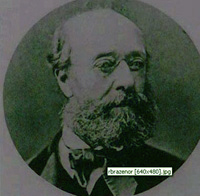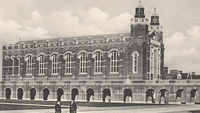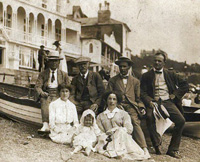
Part 2: Starting a business - The taxidermy work
The most surprising development was the taxidermy. It was far
from dead as Richardon supposed. In a very little while, owls,
canaries, fox masks, hawks, herons, cats etc. came rolling in. At
first we refused to take the orders, but we seemed to be turning
away good money for work for which there was no competition, so I
went to Brighton [and] interviewed Brazenor Bros., the noted
taxidermists in Lewes Rd.
 Robert Brazenor of Brighton,
courtesy of http://www.taxidermy4cash.com/
Robert Brazenor of Brighton,
courtesy of http://www.taxidermy4cash.com/
They listened to my story and finally agreed to attend to all the
work I could send along, and allow me a comfortable commission.
This arrangement worked well for quite a long time when one day, I
was shocked to receive from the authorities at Christs Hospital an
invitation to tender in competition for the complete renovation –
cleaning and re-labelling of the contents of their museum, recently
removed from Newgate Street. A clause in the spec. was “no
subletting”. I approached Brazenor Bros. In confidence to lend me a
man to estimate and, if we got the order, to do the job. To my
surprise, they refused saying they would have nothing to do with it
except under their name. Taylor and I felt rather stumped, not
knowing the first thing about the work so decided to try and find a
taxidermist. We soon discovered they did not grow on trees. After
quite a lot of trouble, we heard of a chap at Peter Spicer and Sons
of Leamington who wanted a change .
Meanwhile we had a snorter of a letter from Mr A.W. Lockhart, the
old steward of Christ’s Hospital asking if we understood what was
intended by “no subletting”. I went to see him at once. He told me
that Brazenors had told him of my visit to them, that they assured
him of our absolute inability either to estimate or execute the
job. He asked what do you intend to do? I assured him we intended
to estimate and, if successful, do the job without subletting, but
I had hoped to borrow one of Brazenor’s staff, this being for us
rather a large and somewhat unusual job. He saw that and we parted
happily, I banking on my man from Leamington. Unfortunately, he
couldn’t get here in time to estimate so we decided to have a
gamble. I went out to look at the job and tried to think of a
figure. Having absolutely no data to base it on, I first thought of
£365 having heard of a mansion somewhere with 365 windows, also
that there were 365 days in a year – and our tender was just, and
only just, lower than that of Rowland Ward[1], the famous firm in Piccadilly. Then I
knew I was safe.
 Chapel at Christ’s Hospital, c.1910,
courtesy of West Sussex Past Pictures; Ref: PP/WSL/PC004670; Rep:
West Sussex County Council Library Service;
Photo credit.
Chapel at Christ’s Hospital, c.1910,
courtesy of West Sussex Past Pictures; Ref: PP/WSL/PC004670; Rep:
West Sussex County Council Library Service;
Photo credit.
In due course our little man from Leamington, Drummond by name, is
due. I go to Horsham Station to meet him, find him a rather
nervous, stuttering little chap, take him home to tea and tell him
of the big job. He is much impressed, feels he is with a firm of
repute who can be trusted with such an order. I had not the guts to
tell him the truth, at least until I had his measure, but he soon
called my bluff. On the way from station, I happened to mention
that I had rather an unpleasant job to start him on. A wealthy lady
had a very favourite cat die on her. She suspected poison and had
tearfully begged me to stuff it. Drummond said. “Oh,
th-th-th-that’s all right. I suppose you have ta-ta-ta-taken his
jacket off and put it in pickle!” I could only weakly reply, “No,
I’m afraid I have not”. “What,” said he, quite aghast, “Why the
hell not?” Well, then I had to come clean, tell him I had not taken
the jacket off because I just did not know how to start. This
rather shook him. He insisted on doing so before tea, pulled out a
little pocket-knife from his waistcoat pocket, did not trouble to
take his nice blue serge jacket off or tuck his cuffs up, just
rolled the repulsive, swollen corpse out of the sack, made a small
incision behind the foreleg, and manipulated the body – head, legs
and all – through it, to my utter amazement, and did not puncture
the body anywhere, explaining that wh-wh-when a cat is poisoned,
they swell, and it is difficult to shrink the skin back to normal
again (The cat still sits on a red velvet cushion in the owner’s
sitting room).
Well, we started the museum job next day, I as his boy. In a week I
had learnt the art and mystery of cleaning any sort of specimen.
Ultimately I relabelled in my very best round hand, was
complimented by the Governors, the job paid handsomely and I was
able to explain to the Governors we also did picture framing,
obtained some large orders in that line. Later on, I solicited the
opportunity for estimating for any building or decorating work. We
were successful in tendering for considerable works over a period
of years under Mr Sydney Tatchall including building the new
Dominions Library. We ultimately came to a sticky end: we were
involved in a row between Mr. Tatchall and Mr Rigby the art master
against the Estate Agent. It was through no fault or default of
ours but, as usual, when architect and client quarrel, the builder
suffers. Mr. Tatchall refused to work under the Estate Agent any
more and we were never again invited to do so. Still. Christ’s
Hospital and our connections with it helped us in many ways. I made
the acquaintance of Mr. Barratt, the senior commercial master. This
afterwards developed into a close personal friendship terminating
only with his death. One of his first acts on learning something of
our history was to place £100 free of interest at our disposal. My
old friend, William Albery[2], the
historian of Horsham, did likewise, and this £200 was the most
valuable capital we ever had.
 An outing to Ventnor, Isle of Wight,
1912. Back row from the left: Billy Hoad; Sylvester Barrett, a
teacher at Christ’s College; Ted Taylor, Billy’s business partner;
Harry Taylor, Ted’s brother. Front row from the left: Jan Taylor,
Ted’s wife; their baby John; Billy’s sister, Kit.
An outing to Ventnor, Isle of Wight,
1912. Back row from the left: Billy Hoad; Sylvester Barrett, a
teacher at Christ’s College; Ted Taylor, Billy’s business partner;
Harry Taylor, Ted’s brother. Front row from the left: Jan Taylor,
Ted’s wife; their baby John; Billy’s sister, Kit.
This brings us to the end of Billy Hoad’s diaries but not quite to
the end of his reflections. The final posting in this series will
tell a story from Billy’s days as a relief postboy in Horsham in
the mid-1880s.
- [1] Rowland Ward
(1848-1912) was a British taxidermist and founder of the taxidermy
firm Rowland Ward Ltd. of Piccadilly. The firm continues to this
day.
Share this
page (third party services may set cookies)